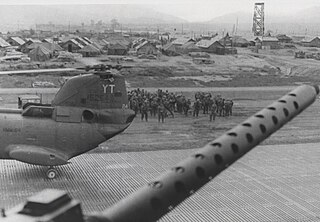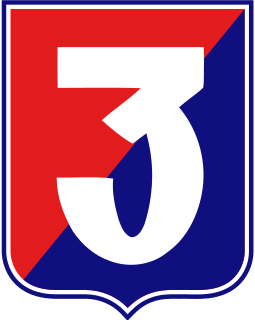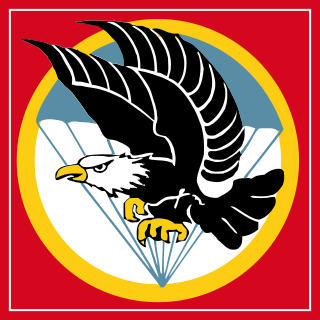
The Army of the Republic of Vietnam, also known as the South Vietnamese army (SVA), were the ground forces of the South Vietnamese military from its inception in 1955 until the Fall of Saigon in 1975. It is estimated to have suffered 1,394,000 casualties during the Vietnam War.
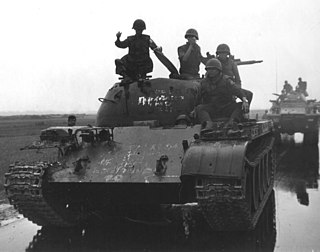
The Easter Offensive, officially known as The 1972 Spring - Summer Offensive by North Vietnam, or Red fiery summer as romanticized in South Vietnamese literature, was a military campaign conducted by the People's Army of Vietnam against the Army of the Republic of Vietnam and the United States military between 30 March and 22 October 1972, during the Vietnam War. This conventional invasion was a radical departure from previous North Vietnamese offensives. The offensive was not designed to win the war outright but to gain as much territory and destroy as many units of the ARVN as possible, to improve the North's negotiating position as the Paris Peace Accords drew towards a conclusion.
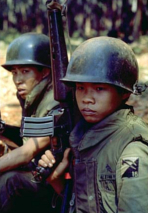
The Battle of Xuan Loc was the last major battle of the Vietnam War in which the Army of the Republic of Vietnam (ARVN) committed almost all their remaining mobile forces, especially the ARVN 18th Infantry Division, under General Lê Minh Đảo to the defence of Xuân Lộc, hoping to stall the advance of the People's Army of Vietnam (PAVN). The battle was fought between April 9 and 21, 1975, and ended when the town of Xuân Lộc was captured by the PAVN 4th Army Corps. This was the ARVN III Corps' last defensive line of South Vietnam's capital, Saigon. The line connected the city of Bình Dương, Bien Hoa Air Base, Vũng Tàu, Long An and the lynchpin centered on the strategic city of Xuân Lộc, where both the ARVN-JGS and RVNAF-JGS committed the nation's final reserve forces in Saigon's defense. Once Xuân Lộc fell on 21 April 1975, the PAVN battled with the last remaining elements of III Corps Armored Task Force, remnants of the 18th Infantry Division, and depleted ARVN Marine, Airborne and Ranger Battalions in a fighting retreat that lasted nine days, until they reached Saigon and PAVN armored columns crashed throughout the gates of South Vietnam's Presidential Palace on 30 April 1975, effectively ending the war.

The Battle of Ban Me Thuot was a decisive battle of the Vietnam War which led to the complete destruction of South Vietnam's II Corps Tactical Zone. The battle was part of a larger North Vietnamese military operation known as Campaign 275 to capture the Tay Nguyen region, known in the West as the Vietnamese Central Highlands.

The Battle of Phước Long was a decisive battle of the Vietnam War which began on December 12, 1974, and concluded on January 6, 1975. The battle involved the deployment of the People's Army of Vietnam (PAVN) 4th Army Corps for the first time, against determined units of the Army of the Republic of Vietnam (ARVN) in Phước Long in Bình Phước Province near the Cambodian border, under the command of Lieutenant General Dư Quốc Đống.

The Battle of An Lộc was a major battle of the Vietnam War that lasted for 66 days and culminated in a tactical victory for South Vietnam. The struggle for An Lộc in 1972 was an important battle of the war, as South Vietnamese forces halted the North Vietnamese advance towards Saigon.

The First Battle of Quảng Trị resulted in the first major victory for the People's Army of Vietnam (PAVN) during the Easter Offensive of 1972. Quảng Trị Province was a major battleground for the opposing forces during the Vietnam War. As South Vietnamese soldiers were gradually replacing their American counterparts, North Vietnam's General Văn Tiến Dũng was preparing to engage three of his divisions in the province. Just months before the battle, the Army of the Republic of Vietnam (ARVN) deployed its newly formed 3rd Division to the areas along the Vietnamese Demilitarized Zone (DMZ) to take over former US bases. North Vietnamese forces deployed against the inexperienced ARVN 3rd Division included the PAVN 304th, 308th and 324B Divisions.

The Second Battle of Quang Tri began on 28 June 1972 and lasted 81 days until 16 September 1972, when South Vietnam's Army of the Republic of Vietnam (ARVN) defeated the North Vietnamese People's Army of Vietnam (PAVN) at the ancient citadel of Quảng Trị and recaptured most of Quảng Trị Province.

PHASE II of the Tet Offensive of 1968 was launched by the People's Army of Vietnam (PAVN) and Viet Cong (VC) against targets throughout South Vietnam, including Saigon from 29 April to 30 May 1968.
Happy Valley was the name given by US Marines to a valley southwest of Danang in Quảng Nam Province, Vietnam
The Battle for Quang Tri occurred in and around Quảng Trị City, the northernmost provincial capital of Republic of South Vietnam during the Tet Offensive when the Vietcong (VC) and People's Army of Vietnam (PAVN) attacked Army of the Republic of Vietnam (ARVN) and American forces across major cities and towns in South Vietnam in an attempt to force the Saigon government to collapse. This included several attacks across northern I Corps, most importantly at Huế, Da Nang and Quảng Trị City. After being put on the defensive in the city of Quảng Trị, the Allied forces regrouped and forced the PAVN/VC out of the town after a day of fighting.

The Hue–Da Nang Campaign was a series of military actions conducted by the People's Army of Vietnam (PAVN) against the Army of the Republic of Vietnam (ARVN) during the Vietnam War, also known in Vietnam as the American War. The campaign was centred on the cities of Huế and Da Nang, with secondary fronts in the provinces of Quảng Trị and Quảng Ngãi. The campaign began on March 5 and concluded on April 2, 1975.
Thường Ðức Camp is a former U.S. Army and Army of the Republic of Vietnam (ARVN) base southwest of Da Nang in Quảng Nam Province, central Vietnam.

Operation Maui Peak was a US Marine Corps operation that took place near the Thường Ðức Camp southwest of Danang, lasting from 1 to 19 October 1968.
The War of the flags was a phase of fighting throughout South Vietnam lasting from 23 January to 3 February 1973 as the forces of North and South Vietnam each sought to maximize the territory under their control before the ceasefire in place agreed by the Paris Peace Accords came into effect on 27 January 1973. The fighting continued past the ceasefire date and into early February. South Vietnamese forces made greater territorial gains and inflicted significant losses on the North Vietnamese forces.
The Battle of Quang Duc took place from 30 October to 10 December 1973 when North Vietnamese forces attempted to occupy part of Quang Duc Province to expand their logistical network from Cambodia into South Vietnam. While the North Vietnamese attacks were initially successful they were eventually forced out by the South Vietnamese.
The Battle of Duc Duc took place from 18 July to 4 October 1974 in Duc Duc District, Quảng Nam Province. The North Vietnamese made some minor territorial gains and suffered heavy losses, while South Vietnamese forces were severely weakened by the fighting.
The Battle of Phú Lộc took place from 28 August to 10 December 1974 when North Vietnamese forces captured a series of hills and installed artillery that closed Phu Bai Air Base and interdicted Highway 1. The hills were recaptured by the South Vietnamese in costly fighting that depleted its reserve forces.


